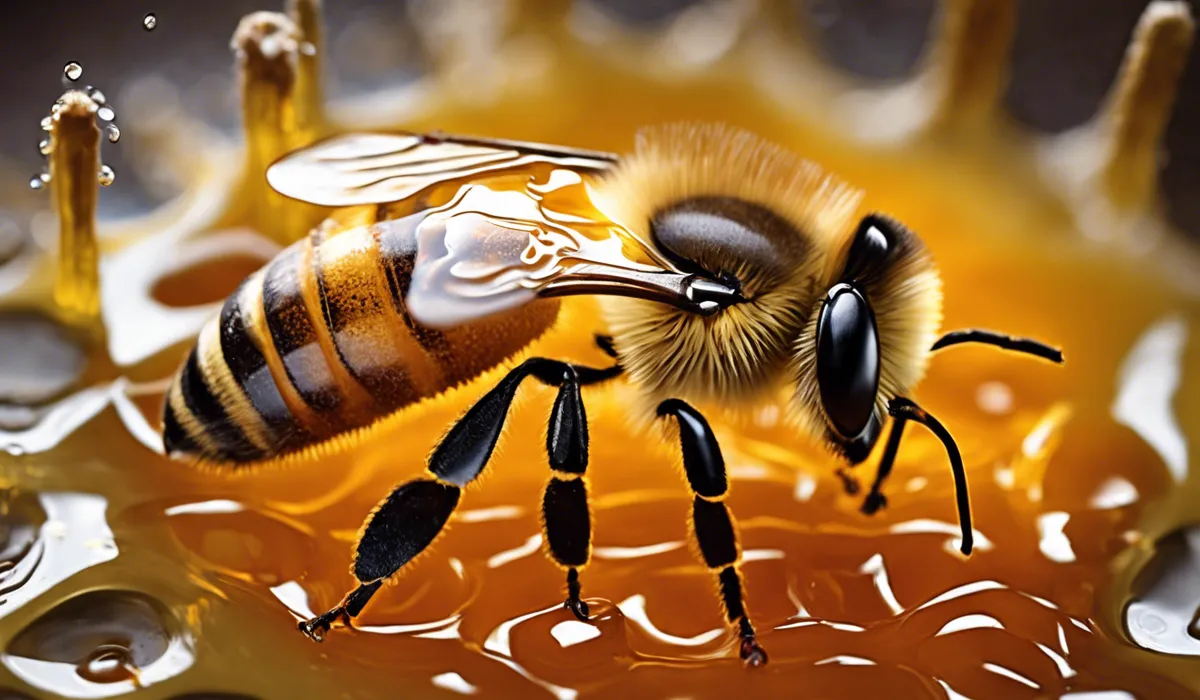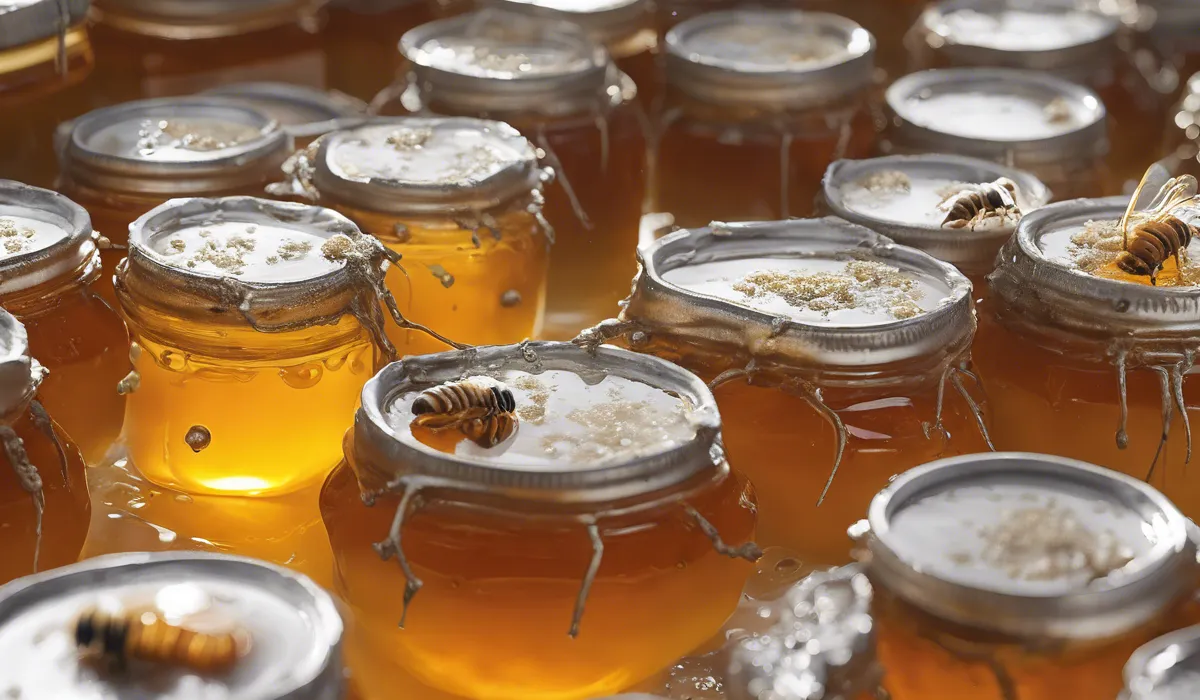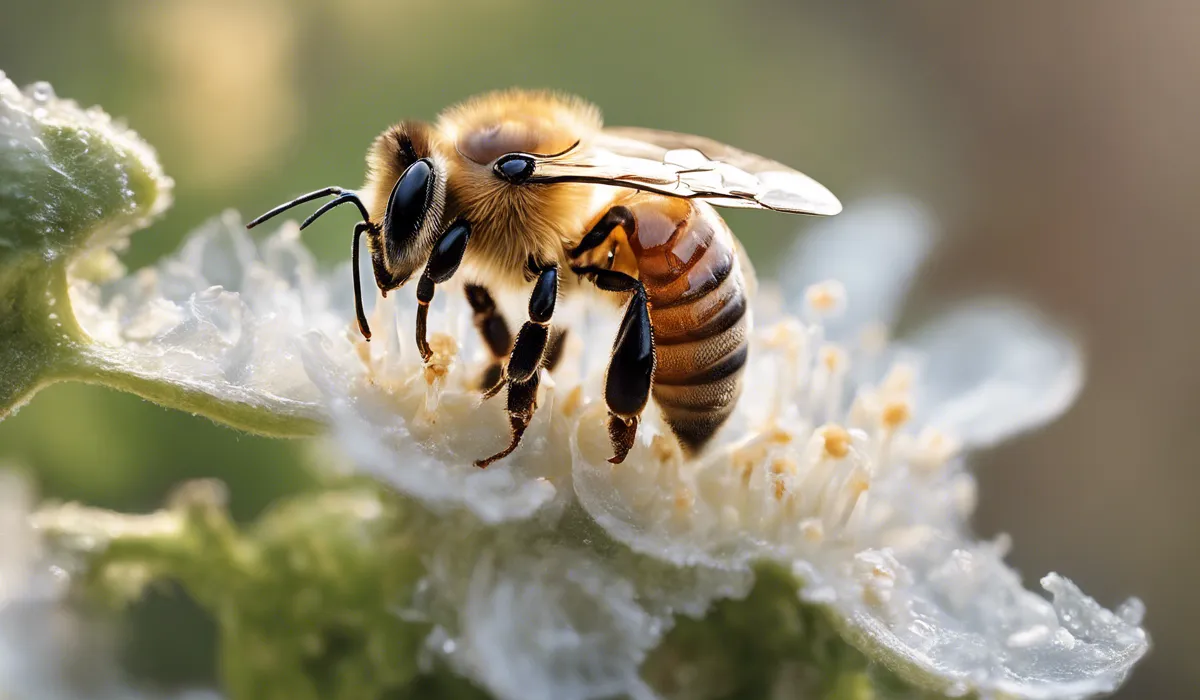Honey itself does not grow mold because it’s low in moisture and highly acidic, creating an unfavorable environment for mold. However, if honey is contaminated with water or other substances, mold can develop on the surface of the contaminated area.
Properties of Honey and Its Resistance to Mold

Natural Composition of Honey
Honey’s natural composition is fascinating and key to its longevity. This sweet substance comes from the hard work of bees and has a low moisture content typically below 18%, making it difficult for microorganisms like mold to survive.
Additionally, honey’s high acidity, with a pH between 3.4 and 6.1, further discourages mold growth.
These qualities ensure that honey remains a stable food product, often lasting for years without spoilage.
Bees and Hydrogen Peroxide
Bees aren’t just honey producers; they are also its protectors. During the honey-making process, bees add an enzyme called glucose oxidase to the nectar.
This enzyme reacts with the sugars in the honey to produce hydrogen peroxide, a natural antiseptic. This hydrogen peroxide gives honey an additional line of defense against mold and other bacteria, ensuring its preservation.
Hygroscopic Nature of Honey
Honey’s hygroscopic nature means it naturally absorbs moisture from the air. While this might seem like a risk for mold growth, honey manages to use this property to its advantage.
By absorbing moisture, honey keeps its water content too low for mold to thrive. This unique characteristic is one of the reasons honey found in ancient tombs could still be edible after thousands of years.
Conditions That Could Lead to Mold Growth in Honey

Rare Circumstances for Mold
While honey is naturally resistant to mold, under certain rare conditions, it can become susceptible.
These conditions are typically linked to outside factors that alter honey’s perfect balance, making it possible for mold to develop.
Understanding these rare circumstances can help honey enthusiasts ensure their honey remains pure and delicious.
Water Contamination Risks
Water contamination is one of the primary risks for mold growth in honey. If honey is exposed to high humidity or comes into contact with water, its moisture content can increase beyond the normal threshold.
When this happens, the environment becomes more hospitable for mold spores to germinate and grow, potentially spoiling the honey.
Improper Storage Issues
Storing honey inappropriately can also lead to mold growth. Honey should be kept in a cool, dry place away from direct sunlight.
If honey is stored in a warm or damp environment, it can spoil more easily. Containers should also be properly sealed to prevent moisture from getting in.
Real-World Mold Observations
Instances of mold in honey are rare, but they have been documented. In some cases, honey stored in non-airtight containers has developed mold on the surface, especially if the honey was harvested too early and contained excess moisture.
These real-world examples highlight the importance of proper honey harvesting and storage techniques.
Preventing Mold and Preserving the Quality of Honey

Best Practices for Storing Honey
To keep honey free from mold, it should be stored correctly. Honey’s ideal storage condition is in a dry place at room temperature.
This helps prevent the absorption of excess moisture which could lead to mold. Honey should not be refrigerated, as the low temperature can cause it to crystallize, which is a natural process but may be mistaken for spoilage.
Container Selection and Sealing Importance
The choice of container for storing honey is crucial. Glass jars with tight-fitting lids are ideal as they do not absorb moisture and can be sealed effectively.
Plastic containers are also common but ensure they are food grade and have a secure lid. A proper seal keeps moisture and air out, safeguarding the honey’s quality over time.
Handling and Usage Recommendations
When using honey, it’s important to use clean, dry utensils to avoid introducing moisture or contaminants.
Every scoop of honey should be taken with care to maintain its purity. By following these simple handling and usage recommendations, honey can remain a staple in the kitchen, free from mold and as flavorful as the day it was collected.
FAQs About Honey and Mold
Can honey grow mold under normal conditions?
No, honey cannot grow mold under normal conditions because it’s low in moisture and acidic, which prevents mold growth.
What can cause mold to grow in honey?
Mold can grow in honey if it is contaminated with water or other substances that increase its moisture content.
Is it safe to eat honey that has mold on it?
No, it is not safe to eat honey with mold, as the mold can produce harmful toxins.
How can one prevent mold from growing in honey?
Keep honey sealed in a dry place and avoid introducing moisture to prevent mold growth.
Does the type of honey affect its susceptibility to mold?
Raw honey may contain more impurities that could lead to mold if it’s improperly stored or contaminated with moisture.
Final Thoughts
Honey’s low moisture content and high acidity naturally inhibit mold growth, making it rare for pure honey to develop mold.
However, if honey becomes diluted with water or other substances, the resulting increase in moisture can allow mold to form on the surface where contamination has occurred.
